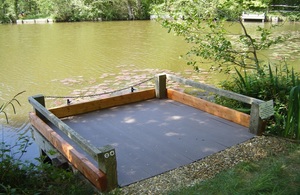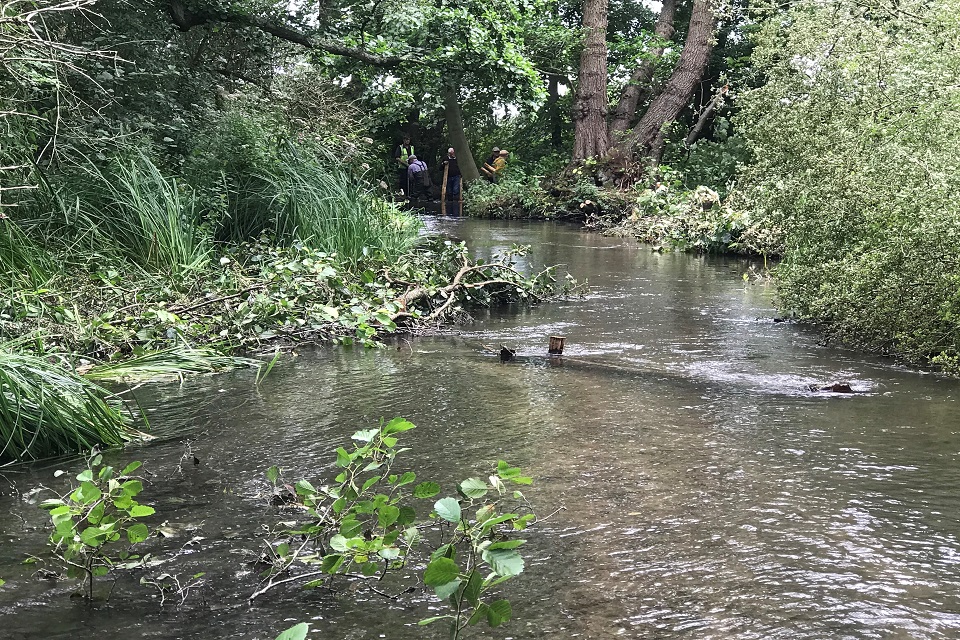South-East anglers hook benefits from Fisheries Improvement Fund
The Environment Agency Fisheries Improvement Programme has invested £3.5 million to fund over 100 projects to enhance England's fisheries.

Hassocks Angling Club, West Sussex - fishing platform
In the South East, funding has helped many projects such as the creation of new fish passes, protecting fish stocks, providing new angling platforms, and improving accessibility so more people than ever are able to enjoy the sport.
A number of significant projects across the South East have already been completed in the last year (see examples below) with more projects due to finish over the next few months thanks to the funding.
Arnie Warsop, an Environment Agency local fisheries officer said:
Anglers often ask us about how we spend the money raised from the sale of fishing licences. The Fisheries Improvement Programme is a prime example of the wide range of activities this income pays for to protect and improve fish stocks and fisheries and boost the popularity of angling.
The programme is also a great demonstration of our partnership efforts, with many of the projects completed with the support of landowners, local businesses and fisheries clubs – it’s a real team effort! The more people who go fishing, the more we can invest and the more projects we can deliver.
All the projects will benefit anglers and local partners provide significant match funding and input from volunteers to make them a success. We want to hear from more clubs and fisheries about the work and projects they would like to see undertaken.
Hassocks Angling Club (AC) Swim Creation (West Sussex)
FIP funding was used to purchase decking and construction materials which club members then used to create disabled angling platforms to improve lake access for all club members.
Laybrook Lake habitat Improvement (West Sussex)
The banks on Byron lake were suffering from erosion and undercutting, potentially causing them to be unsafe for anglers at the Worthing & District Piscatorial Society. Funding enabled the eroded bank to be re-graded and the surrounding habitat enhanced. The works included bank re-profiling, new angling swims, emergent marginal planting to create fish refuge and spawning locations with hedge (hawthorn, blackthorn, hazel) and pollinator/wildflower meadow planting.
Peewit Lake (Hampshire)
Funds from the Environment Agency contributed to a project run by Eastleigh and District Angling Club which saw the construction and improvement of 16 swims (areas where anglers can access the water) at Peewit lake - improving the angling experience for all.
Panshanger Park, River Mimram (Hertfordshire)
Improvements in the in-channel habitat for riverine fish species such as wild brown trout, grayling, bullheads and minnows within an important Hertfordshire chalk stream. Strategic felling of 25 trees allowed sunlight to penetrate the already over-shaded channel. Soft engineering methods were used such as tree hinging which helped to create marginal cover. Work undertaken will help improve overall biodiversity in the chalk stream, improve refuge areas for juvenile fish and provide cleaner more suitable spawning gravels for fish and the invertebrate communities for years to come.

Improvements in the in-channel habitat for riverine fish.
## Fordcombe River Medway (Kent) With the help of the Environment Agency, the Royal Tunbridge Wells Angling Society purchased and installed coir rolls, flow defectors and stone on the River Medway, downstream of Fordcombe. This will help continue to improve instream habitat for spawning and juvenile fish, leading to increased and sustainable fish populations.
Railway Pond (West Oxfordshire)
Wantage & Grove Angling Club’s Railway Pond venue was suffering from bank erosion. The funding helped to pay for bank repair work which also included the installation of a British Disabled Angler Association approved platform. To mitigate for the loss of natural bank, several floating islands, planted with native plant species, were also installed. The Environment Agency Fisheries Team has been working with the club for a number of years to help make improvements to the fishery and to provide resilience in times of prolonged dry weather.
Since FIP was established in 2015, over 850 projects have been successfully completed, with a total of £6 million invested from fishing licence sales alone. These projects continue to positively impact fisheries, angling, ecosystems, and local communities across England.
Every penny the Environment Agency receives in fishing licence income is reinvested to improve our fisheries and protect England’s waterways.
Fishing licences can be purchased here: https://www.gov.uk/fishing-licences/buy-a-fishing-licence